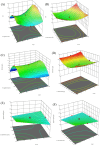Enhancing pigment production by a chromogenic bacterium (Exiguobacterium aurantiacum) using tomato waste extract: A statistical approach
- PMID: 40549778
- PMCID: PMC12184941
- DOI: 10.1371/journal.pone.0312922
Enhancing pigment production by a chromogenic bacterium (Exiguobacterium aurantiacum) using tomato waste extract: A statistical approach
Abstract
There is a high demand for microbial pigments as a promising alternative for synthetic pigments, primarily for safety and economic reasons. This study aimed at the optimization of yellowish-orange pigment production by Exiguobacterium aurantiacum using agro-waste extracts as a growth substrate. Air samples were collected using the depositional method. Pure cultures of pigment producing bacteria were isolated by subsequent culturing on fresh nutrient agar medium. The potent isolate was identified using MALDI-TOF technique. Screening of culture conditions was done via Plackett-Burman design that highlighted culture agitation rate, initial medium pH, and yeast extract concentration as the most significant variables (p < 0.0001) in influencing pigment production with further optimization step using response surface methodology. Among the tested agro-waste decoctions, tomato waste extract was selected for fermentation due to higher optical density of the isolate when cultivated in it compared to the other agro-waste extracts. Under optimized conditions, 0.96 g/L of pigment was extracted from 4.73 g/L of culture biomass, representing a 1.6-fold increase compared to un-optimized conditions. Spectroscopic and chromatographic analyses confirmed the presence of various functional groups, with carotenoids identified as the primary compounds responsible for the yellowish-orange pigmentation. These findings demonstrate the feasibility of enhancing bacterial pigment production using agro-waste substrates, highlighting its potential for large-scale industrial applications.
Copyright: © 2025 Zeleke et al. This is an open access article distributed under the terms of the Creative Commons Attribution License, which permits unrestricted use, distribution, and reproduction in any medium, provided the original author and source are credited.
Conflict of interest statement
The authors have declared that no competing interests exist.
Figures









Similar articles
-
Biosourcing and optimization of fungal lipase production from cheap agro waste via solid state fermentation.Sci Rep. 2025 Jul 1;15(1):20967. doi: 10.1038/s41598-025-06505-9. Sci Rep. 2025. PMID: 40596505 Free PMC article.
-
Intravenous magnesium sulphate and sotalol for prevention of atrial fibrillation after coronary artery bypass surgery: a systematic review and economic evaluation.Health Technol Assess. 2008 Jun;12(28):iii-iv, ix-95. doi: 10.3310/hta12280. Health Technol Assess. 2008. PMID: 18547499
-
Systemic pharmacological treatments for chronic plaque psoriasis: a network meta-analysis.Cochrane Database Syst Rev. 2021 Apr 19;4(4):CD011535. doi: 10.1002/14651858.CD011535.pub4. Cochrane Database Syst Rev. 2021. Update in: Cochrane Database Syst Rev. 2022 May 23;5:CD011535. doi: 10.1002/14651858.CD011535.pub5. PMID: 33871055 Free PMC article. Updated.
-
Selegiline for Alzheimer's disease.Cochrane Database Syst Rev. 2003;(1):CD000442. doi: 10.1002/14651858.CD000442. Cochrane Database Syst Rev. 2003. PMID: 12535396
-
Signs and symptoms to determine if a patient presenting in primary care or hospital outpatient settings has COVID-19.Cochrane Database Syst Rev. 2022 May 20;5(5):CD013665. doi: 10.1002/14651858.CD013665.pub3. Cochrane Database Syst Rev. 2022. PMID: 35593186 Free PMC article.
References
-
- Akter T, Protity AT, Shaha M, Al Mamun M, Hashem A. The Impact of Textile Dyes on the Environment. Nanohybrid Materials for Treatment of Textiles Dyes. Springer Nature Singapore; 2023. p. 401–31. doi: 10.1007/978-981-99-3901-5_17 - DOI
-
- Drumond Chequer FM, de Oliveira GAR, Anastacio Ferraz ER, Carvalho J, Boldrin Zanoni MV, de Oliveir DP. Textile Dyes: Dyeing Process and Environmental Impact. Eco-Friendly Textile Dyeing and Finishing. InTech. 2013. doi: 10.5772/53659 - DOI
-
- Singha K, Pandit P, Maity S, Sharma SR. Harmful environmental effects for textile chemical dyeing practice. Green Chemistry for Sustainable Textiles. Elsevier; 2021. p. 153–64. doi: 10.1016/b978-0-323-85204-3.00005-1 - DOI
MeSH terms
Substances
LinkOut - more resources
Full Text Sources

